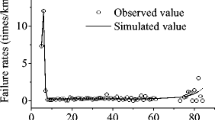Abstract
Condition assessment (CA) Modeling is drawing increasing interest as a technique that can assist in managing drinking water infrastructure. This paper develops a model based on the application of a Cox proportional hazard (PH)/shared frailty model and applies it to evaluating the risk of failure in drinking water networks using data from the Laramie Water Utility (located in Laramie, Wyoming, USA). Using the risk model a cost/ benefit analysis incorporating the inspection value method (IVM), is used to assist in making improved repair, replacement and rehabilitation decisions for selected drinking water distribution system pipes. A separate model is developed to predict failures in prestressed concrete cylinder pipe (PCCP). Various currently available inspection technologies are presented and discussed.
Similar content being viewed by others
References
Brechling V J (1995). A Methodology for the Economic Assessment of Nondestructive Evaluation Techniques Used in Aircraft Inspection. Report No. DOT/FAA/AR-95/101 National Technical Information Service (NTIS), Springfield, USA
Clark RM, Carson J H, Thurnau R C, Krishnan E R, Panguluri S (2010). Condition assessment modeling for distribution systems using shared frailty analysis. JAWWA, 7(102): 81–91
Clark R M, Sivaganesan M, Selvakumar A, Sethi V (2002). Costs models for water supply distribution systems. J Water Resour Plan Manage, 128(5): 312–321
Galleher J J, Holley M, Shenkiryk M, Eaton G (2007). Snap, crack, pop-Recording of a prestressed pipe failure. Advances and Experiences in with Trenchless Projects, ASCE, 1–9
Higgins M S, Gadoury, Razza R, Mead I (2007). Technologies to assess and manage providence’s water’s 102 inch PCCP aqueduct. Advances and Experiences with Trenchless Projects, ASCE, 1–8
Lam K F, Kuk A Y C (1997). A marginal likelihood approach to estimation in frailty models. J Am Stat Assoc, 439(92): 985–990
Padewski E, Leshner N, Woodcock M, Higgins M (2007). Assessing PCCP Transmission Mains. Pipelines Specialty Conference, ASCE, 1–6
Rajani B, Kleiner Y (2004). Non-destructive Techniques to Determine Structural Distress Indicators in Water Mains. In: Evaluation and Control of Water Loss in Urban Networks, Valencia, Spain, June 21–25, 1–20
Rogers P D (2006). Failure assessment model to prioritize pipe replacement in water utility asset management. A thesis submitted in partial fulfillment of the requirements for the Degree of Doctor of Philosophy, Colorado State University
Royer M D (2005). White paper on improvement of structural integrity monitoring for drinking water mains. National Risk Management Research Laboratory, Office of Research and Development, USEPA, Cincinnati, USA
USEPA (2007). Distribution System Inventory, Integrity and Water Quality. Office of Water, Washington DC, USA
Wall M, Wedgewood F A, Martens W (1998). Economic assessment of inspection-The inspection value method. NDT.net, 3(12)
Author information
Authors and Affiliations
Corresponding author
Rights and permissions
About this article
Cite this article
Clark, R.M., Thurnau, R.C. Evaluating the risk of water distribution system failure: A shared frailty model. Front. Earth Sci. 5, 400–405 (2011). https://doi.org/10.1007/s11707-011-0195-9
Received:
Accepted:
Published:
Issue Date:
DOI: https://doi.org/10.1007/s11707-011-0195-9




